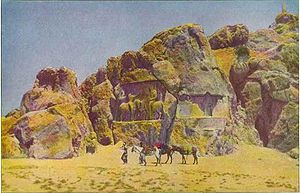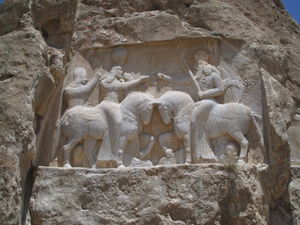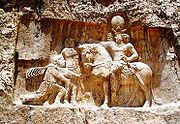
Naqsh-e Rustam
Encyclopedia
Naqsh-e Rustam also referred to as Necropolis
is an archaeological site located about 12 km northwest of Persepolis
, in Fars province, Iran
. Naqsh-e Rustam lies a few hundred meters from Naqsh-e Rajab
.
The oldest relief at Naqsh-i Rustam is severely damaged and dates to c. 1000 BC. It depicts a faint image of a man with unusual head-gear and is thought to be Elam
ite in origin. The depiction is part of a larger mural, most of which was removed at the command of Bahram II
. The man with the unusual cap gives the site its name, Naqsh-e Rostam, "Picture of Rostam", because the relief was locally believed to be a depiction of the mythical hero Rostam
.

 Four tombs belonging to Achaemenid kings are carved out of the rock face. They are all at a considerable height above the ground.
Four tombs belonging to Achaemenid kings are carved out of the rock face. They are all at a considerable height above the ground.
The tombs are known locally as the 'Persian crosses', after the shape of the facades of the tombs. The entrance to each tomb is at the center of each cross, which opens onto to a small chamber, where the king lay in a sarcophagus. The horizontal beam of each of the tomb's facades is believed to be a replica of the entrance of the palace at Persepolis
.
One of the tombs is explicitly identified by an accompanying inscription to be the tomb of Darius I the Great (c. 522-486 BC). The other three tombs are believed to be those of Xerxes I (c. 486-465 BC), Artaxerxes I (c. 465-424 BC), and Darius II
(c. 423-404 BC) respectively. A fifth unfinished one might be that of Artaxerxes III, who reigned at the longest two years, but is more likely that of Darius III (c. 336-330 BC), last of the Achaemenid dynasts.
The tombs were looted following the conquest of the Achaemenid empire by Alexander the Great.


 Seven oversized rock reliefs at Naqsh-e Rustam depict monarchs of the Sassanid period.
Seven oversized rock reliefs at Naqsh-e Rustam depict monarchs of the Sassanid period.
made casts of the inscriptions on the tomb of Darius I. Since 1946, these casts are held in the archives of the Freer Gallery of Art
and the Arthur M. Sackler Gallery
, Smithsonian Institution, in Washington, DC.
Naqsh-e Rustam was excavated for several seasons between 1936 and 1939 by a team from the Oriental Institute
of the University of Chicago
, led by Erich Schmidt.
Necropolis
A necropolis is a large cemetery or burial ground, usually including structural tombs. The word comes from the Greek νεκρόπολις - nekropolis, literally meaning "city of the dead"...
is an archaeological site located about 12 km northwest of Persepolis
Persepolis
Perspolis was the ceremonial capital of the Achaemenid Empire . Persepolis is situated northeast of the modern city of Shiraz in the Fars Province of modern Iran. In contemporary Persian, the site is known as Takht-e Jamshid...
, in Fars province, Iran
Iran
Iran , officially the Islamic Republic of Iran , is a country in Southern and Western Asia. The name "Iran" has been in use natively since the Sassanian era and came into use internationally in 1935, before which the country was known to the Western world as Persia...
. Naqsh-e Rustam lies a few hundred meters from Naqsh-e Rajab
Naqsh-e Rajab
Naqsh-e Rajab is an archaeological site just east of Istakhr and about 12 km north of Persepolis.Together with Naqsh-e Rustam, which lies less than a kilometer away, the site is part of the Marvdasht cultural complex...
.
The oldest relief at Naqsh-i Rustam is severely damaged and dates to c. 1000 BC. It depicts a faint image of a man with unusual head-gear and is thought to be Elam
Elam
Elam was an ancient civilization located in what is now southwest Iran. Elam was centered in the far west and the southwest of modern-day Iran, stretching from the lowlands of Khuzestan and Ilam Province, as well as a small part of southern Iraq...
ite in origin. The depiction is part of a larger mural, most of which was removed at the command of Bahram II
Bahram II
Bahram II was the fifth Sassanid King of Persia in 276–293. He was the son of Bahram I .Bahram II is said to have ruled at first tyrannically, and to have greatly disgusted all his principal nobles, who went so far as to form a conspiracy against him, and intended to put him to death...
. The man with the unusual cap gives the site its name, Naqsh-e Rostam, "Picture of Rostam", because the relief was locally believed to be a depiction of the mythical hero Rostam
Rostam
Rostam is the national hero of Greater Iran from Zabulistan in Persian mythology and son of Zal and Rudaba. In some ways, the position of Rostam in the historical tradition is parallel to that of Surena, the hero of the Carrhae. His figure was endowed with many features of the historical...
.
Achaemenid tombs


The tombs are known locally as the 'Persian crosses', after the shape of the facades of the tombs. The entrance to each tomb is at the center of each cross, which opens onto to a small chamber, where the king lay in a sarcophagus. The horizontal beam of each of the tomb's facades is believed to be a replica of the entrance of the palace at Persepolis
Persepolis
Perspolis was the ceremonial capital of the Achaemenid Empire . Persepolis is situated northeast of the modern city of Shiraz in the Fars Province of modern Iran. In contemporary Persian, the site is known as Takht-e Jamshid...
.
One of the tombs is explicitly identified by an accompanying inscription to be the tomb of Darius I the Great (c. 522-486 BC). The other three tombs are believed to be those of Xerxes I (c. 486-465 BC), Artaxerxes I (c. 465-424 BC), and Darius II
Darius II
Darius II , was king of the Persian Empire from 423 BC to 405 BC.Artaxerxes I, who died on December 25, 424 BC, was followed by his son Xerxes II. After a month and a half Xerxes II was murdered by his brother Secydianus or Sogdianus...
(c. 423-404 BC) respectively. A fifth unfinished one might be that of Artaxerxes III, who reigned at the longest two years, but is more likely that of Darius III (c. 336-330 BC), last of the Achaemenid dynasts.
The tombs were looted following the conquest of the Achaemenid empire by Alexander the Great.
Sassanid reliefs



- The investiture relief of Ardashir IArdashir IArdashir I was the founder of the Sassanid Empire, was ruler of Istakhr , subsequently Fars Province , and finally "King of Kings of Sassanid Empire " with the overthrow of the Parthian Empire...
(c. 226-242):
- The founder of the Sassanid EmpireSassanid EmpireThe Sassanid Empire , known to its inhabitants as Ērānshahr and Ērān in Middle Persian and resulting in the New Persian terms Iranshahr and Iran , was the last pre-Islamic Persian Empire, ruled by the Sasanian Dynasty from 224 to 651...
is seen being handed the ring of kingship by Ahura MazdaAhura MazdaAhura Mazdā is the Avestan name for a divinity of the Old Iranian religion who was proclaimed the uncreated God by Zoroaster, the founder of Zoroastrianism...
. In the inscription, which also bears the oldest attested use of the term 'Iran' (see "etymology of 'Iran'Etymology of IranThe name of Iran derives immediately from Middle Persian Ērān, Pahlavi ʼyrʼn, first attested in this form in the inscription that accompanies the investiture relief of Ardashir I at Naqsh-e Rustam...
" for details), Ardashir admits to betraying his pledge to Artabanus IV (the Persians having been a vassal state of the Arsacid ParthiansParthian EmpireThe Parthian Empire , also known as the Arsacid Empire , was a major Iranian political and cultural power in ancient Persia...
), but legitimizes his action on the grounds that Ahura Mazda had wanted him to do so.
- The triumph of Shapur IShapur IShapur I or also known as Shapur I the Great was the second Sassanid King of the Second Persian Empire. The dates of his reign are commonly given as 240/42 - 270/72, but it is likely that he also reigned as co-regent prior to his father's death in 242 .-Early years:Shapur was the son of Ardashir I...
(c. 241-272):
- This is the most famous of the Sassanid rock reliefs, and depicts Shapur's victory over two Roman emperors, ValerianValerian (emperor)Valerian , also known as Valerian the Elder, was Roman Emperor from 253 to 260. He was taken captive by Persian king Shapur I after the Battle of Edessa, becoming the only Roman Emperor who was captured as a prisoner of war, resulting in wide-ranging instability across the Empire.-Origins and rise...
and Philip the ArabPhilip the ArabPhilip the Arab , also known as Philip or Philippus Arabs, was Roman Emperor from 244 to 249. He came from Syria, and rose to become a major figure in the Roman Empire. He achieved power after the death of Gordian III, quickly negotiating peace with the Sassanid Empire...
. A more elaborate version of this rock relief is at BishapurBishapurthumb|Irano-Roman floor mosaic detail from the palace of [[Shapur I]] at BishapurBishapur is an ancient city situated south of modern Faliyan, Iran on the ancient road between Persis and Elam. The road linked the Sassanid capitals Istakhr and Ctesiphon...
.
- The "grandee" relief of Bahram IIBahram IIBahram II was the fifth Sassanid King of Persia in 276–293. He was the son of Bahram I .Bahram II is said to have ruled at first tyrannically, and to have greatly disgusted all his principal nobles, who went so far as to form a conspiracy against him, and intended to put him to death...
(c. 276-293):
- On each side of the king, who is depicted with an oversized sword, figures face the king. On the left stand five figures, perhaps members of the king's family (three having diadems, suggesting they were royalty). On the right stand three courtiers, one of which may be KartirKartirKartir Hangirpe was a highly influential Zoroastrian high-priest of the late 3rd century CE and served as advisor to at least three Sassanid emperors....
. This relief is to the immediate right of the investiture inscription of Ardashir (see above), and partially replaces the much older relief that gives Naqsh-e Rustam its name.
- The two equestrian reliefs of Bahram IIBahram IIBahram II was the fifth Sassanid King of Persia in 276–293. He was the son of Bahram I .Bahram II is said to have ruled at first tyrannically, and to have greatly disgusted all his principal nobles, who went so far as to form a conspiracy against him, and intended to put him to death...
(c. 276-293):
- The first equestrian relief, located immediately below the fourth tomb (perhaps that of Darius II), depicts the king battling a mounted Roman soldier.
- The second equestrian relief, located immediately below the tomb of Darius I, is divided into two registers, an upper and a lower one. In the upper register, the king appears to be forcing a Roman enemy from his horse. In the lower register, the king is again battling a mounted Roman soldier.
- Both reliefs depict a dead enemy under the hooves of the king's horse.
- The investiture of NarsehNarsehNarseh was the seventh Sassanid King of Persia , and son of Shapur I ....
(c. 293-303):
- In this relief, the king is depicted as receiving the ring of kingship from a female figure that is frequently assumed to be the divinity Aredvi Sura Anahita. However, the king is not depicted in a pose that would be expected in the presence of a divinity, and it hence likely that the woman is a relative, perhaps Queen Shapurdokhtak.
- The equestrian relief of Hormizd IIHormizd IIHormizd II, was the eighth Persian king of the Sassanid Empire, and reigned for seven years and five months, from 302 to 309. He was the son of Narseh .Almost nothing is known of his reign...
(c. 303-309):
- This relief is below tomb 3 (perhaps that of Artaxerxes I) and depicts Hormizd forcing an enemy (perhaps Papak of Armenia) from his horse. Immediately above the relief and below the tomb is a badly damaged relief of what appears to be Shapur IIShapur IIShapur II the Great was the ninth King of the Persian Sassanid Empire from 309 to 379 and son of Hormizd II. During his long reign, the Sassanid Empire saw its first golden era since the reign of Shapur I...
(c. 309-379) accompanied by courtiers.
Archaeology
In 1923, the German archaeologist Ernst HerzfeldErnst Herzfeld
Ernst Emil Herzfeld was a German archaeologist and Iranologist.-Life:Herzfeld was born in Celle, Province of Hanover...
made casts of the inscriptions on the tomb of Darius I. Since 1946, these casts are held in the archives of the Freer Gallery of Art
Freer Gallery of Art
The Freer Gallery of Art joins the Arthur M. Sackler Gallery to form the Smithsonian Institution's national museums of Asian art. The Freer contains art from East Asia, South Asia, Southeast Asia, the Islamic world, the ancient Near East, and ancient Egypt, as well as a significant collection of...
and the Arthur M. Sackler Gallery
Arthur M. Sackler Gallery
The Arthur M. Sackler Gallery joins the Freer Gallery of Art to form the Smithsonian Institution's national museums of Asian art. The Sackler celebrates its twenty-fifth anniversary in 2012....
, Smithsonian Institution, in Washington, DC.
Naqsh-e Rustam was excavated for several seasons between 1936 and 1939 by a team from the Oriental Institute
Oriental Institute
Oriental Institute may refer to a number of institutes of Oriental studies:United States* Oriental Institute, Chicago, part of the University of ChicagoEngland* Oriental Institute, Oxford, part of the University of Oxford...
of the University of Chicago
University of Chicago
The University of Chicago is a private research university in Chicago, Illinois, USA. It was founded by the American Baptist Education Society with a donation from oil magnate and philanthropist John D. Rockefeller and incorporated in 1890...
, led by Erich Schmidt.
See also
- PersepolisPersepolisPerspolis was the ceremonial capital of the Achaemenid Empire . Persepolis is situated northeast of the modern city of Shiraz in the Fars Province of modern Iran. In contemporary Persian, the site is known as Takht-e Jamshid...
- Behistun InscriptionBehistun InscriptionThe Behistun Inscription The Behistun Inscription The Behistun Inscription (also Bistun or Bisutun, Modern Persian: بیستون The Behistun Inscription (also Bistun or Bisutun, Modern Persian: بیستون...
- Cities of the Ancient Near EastCities of the ancient Near EastThe largest cities in the Bronze Age ancient Near East housed several tens of thousands. Memphis in the Early Bronze Age with some 30,000 inhabitants was the largest city of the time by far...
- Ka'ba-i Zartosht (The "Cube of Zoroaster", a monument at Naqsh-e Rustam)
- List Of Colossal Sculpture In Situ
- Naqsh-e RajabNaqsh-e RajabNaqsh-e Rajab is an archaeological site just east of Istakhr and about 12 km north of Persepolis.Together with Naqsh-e Rustam, which lies less than a kilometer away, the site is part of the Marvdasht cultural complex...
- PasargadaePasargadaePasargadae , the capital of Cyrus the Great and also his last resting place, was a city in ancient Persia, and is today an archaeological site and one of Iran's UNESCO World Heritage Sites.-History:...
(Tomb of Pasargadae Cyrus the GreatCyrus the GreatCyrus II of Persia , commonly known as Cyrus the Great, also known as Cyrus the Elder, was the founder of the Achaemenid Empire. Under his rule, the empire embraced all the previous civilized states of the ancient Near East, expanded vastly and eventually conquered most of Southwest Asia and much...
) - Taq-e BostanTaq-e BostanTaqwasân or Taq-e Bostan or Taq-i-Bustan is a series of large rock relief from the era of Sassanid Empire of Persia, the Iranian dynasty which ruled western Asia from 226 to 650 AD. This example of Sassanid art is located 5 km from the city center of Kermanshah in western Iran...
(Rock reliefs of various Sassanid kings) - Valley of the KingsValley of the KingsThe Valley of the Kings , less often called the Valley of the Gates of the Kings , is a valley in Egypt where, for a period of nearly 500 years from the 16th to 11th century BC, tombs were constructed for the Pharaohs and powerful nobles of the New Kingdom .The valley stands on the west bank of...
- Ming and Qing Imperial TombsImperial Tombs of the Ming and Qing DynastiesImperial Tombs of the Ming and Qing Dynasties is the designation under which the UNESCO has included several tombs and burial complexes into the list of World Heritage Sites. These tombs date from the Ming and Qing dynasties of China....
External links
- Ernst Herzfeld Papers, Series 5: Drawings and Maps, Records of Naqsh-i Rustam Collections Search Center, S.I.R.I.S., Smithsonian Institution, Washington, D.C.

